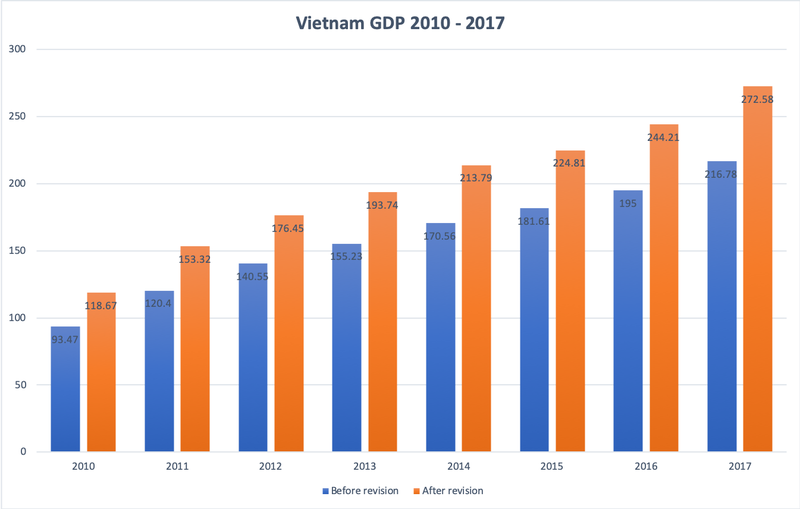Vietnam’s GDP in 2017 is estimated at VND6,294 trillion (US$272.77 billion) after revision, representing an increase of VND1,300 trillion (US$56.34 billion) against the previous figure of VND5,006 trillion (US$216.95 billion), according to the General Statistics Office (GSO).
 |
This would result in revised GDP per capita of US$2,985, higher than the preceding number of US$2,343, stated the GSO in a statement announcing the result of GDP revision in the 2010 – 2017 period held Friday.
As a result, Vietnam’s GDP grew an average of 25.4% annually in 2010 – 2017, in which 2011 recorded the highest growth rate of 27.3% and 2015 grew the lowest rate of 23.8%.
Among economic sectors, services posted the highest growth rates after revision with an additional increase of VND316 – 615 trillion (US$13.68 – 26.61 billion) per year, equivalent to growth rates of 29.8 – 39.6%. It is followed by industrial and construction sector with an additional VND211 – 555 trillion (US$9.14 – 24.04 billion) or 27.6 – 36.6%, and the agro – fishery – forestry sector with VND25 – 46 trillion (US$1.08 – 2 billion), or 5.4 – 6.2%.
According to the GSO, after revision, “the GDP structure now better reflects the shift of the economy.” The agro – fishery – forestry expanded an average of 14.7% in the 2010 – 2017 period, down 2.7 percentage points from previous figures; the construction and industrial sector saw increases of 33 – 34.8%, up 1.8 percentage points; and the services rose by 39.2 – 41.2%, up two percentage points.
Notably, there were no major changes to the annual growth rates of GDP compared to the previously announced rates. The rates were revised up by 0.13 – 0.48 percentage points, with 2016 seeing the highest increase of 0.48 percentage points.
As such, GDP growth rates from 2011 to 2017 are 6.41%; 5.50%; 5.55%; 6.42%; 6.99%; 6.69%; and 6,94%, respectively.
Due to a change in the size of the economy, in addition to higher GDP per capita, other key economic indicators in 2017 are now adjusted accordingly. For example, the ratio of public debt to GDP as of the end of 2017 has been revised dow to 48.8%, fiscal deficit to 2.8%, and the ratio of state budget expenditure to GDP to 21.5%, among others.
Why revision now?
The GSO pointed to five reasons that lead to different GDP results, in which new data emerged from the general survey is considered to have the biggest impact, leading to an average increase of VND589 trillion (US$25.51 billion) in GDP annually, accounting for 63% of the incremental level.
The second reason is new data from administrative documents that led to an average increase of VND305 trillion (US$13.21 billion) in GDP annually, or 32.6% of the increased level.
The GSO said a revision of the GDP is aimed to better reflect the economic performance and efficiency of economic policies.
Policy makers would take these new data as basis for drafting Vietnam’s socio-economic development 2021 – 2030 and 2021 – 2025, stated the GSO.
The GSO reiterated its previous statement that revising GDP is a common practice globally, and countries such as the US, Canada, Germany, Russia, Italy, Indonesia, among others, have made similar moves since 2010.
China revised its GDP growth in 2004, 2008, 2013 and 2015, with the two latest revisions having added US$305 and US$141 billion to the existing statistics.
In the 2013 – 2014 period, after being revised, Russia’s GDP expanded an extra 24.3%, the economies of Rumania and Croatia enlarged 28.4%, Germany's 3%, Italy's 7% after their respective GDP calculation was reviewed.
In July 2013, the US revised its GDP growth of the previous year and added US$506 billion to its economy.
GSO Head Nguyen Bich Lam previously said this was not the first time the GSO revises the GDP calculation. His agency in 2013 revised the GDP in the 2008 – 2012 period. Six years ago, the revision only focused on certain sectors such as banking, finance, insurance and real estate, Lam stated, noting this time the GSO would include all economic groups in the economy, except the illegal and shadow economies, due to the lack of data. Hanoitimes
Hai Yen

Local G-bond market value reaches over 25% of GDP
The size of the local Government bond (G-bond) market by the end of last month was equal to 25.1% of the country’s gross domestic product in 2019, marking a 12-fold
 After revision, Vietnam’s GDP grew an average of 25.4% annually in the 2010 – 2017 period, in which 2011 recorded the highest growth rate of 27.3%.
After revision, Vietnam’s GDP grew an average of 25.4% annually in the 2010 – 2017 period, in which 2011 recorded the highest growth rate of 27.3%.